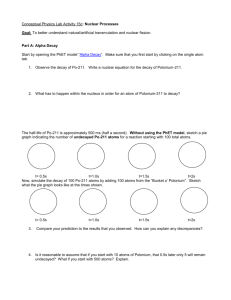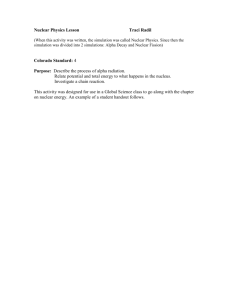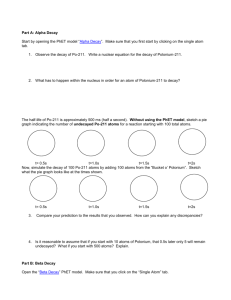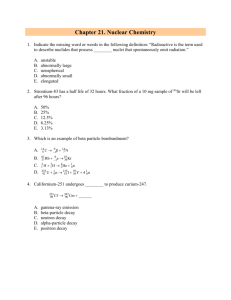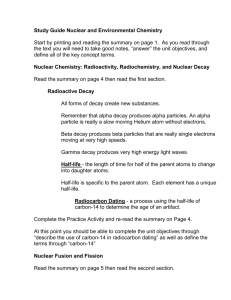PHET Nuclear Lab
advertisement
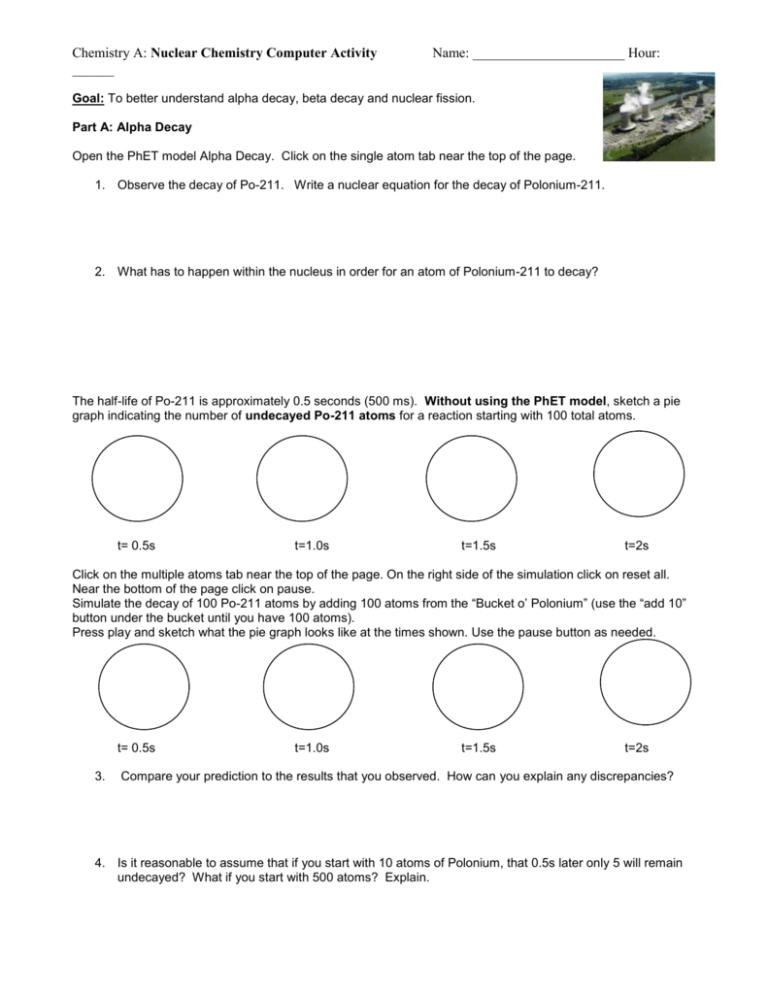
Chemistry A: Nuclear Chemistry Computer Activity ______ Name: ______________________ Hour: Goal: To better understand alpha decay, beta decay and nuclear fission. Part A: Alpha Decay Open the PhET model Alpha Decay. Click on the single atom tab near the top of the page. 1. Observe the decay of Po-211. Write a nuclear equation for the decay of Polonium-211. 2. What has to happen within the nucleus in order for an atom of Polonium-211 to decay? The half-life of Po-211 is approximately 0.5 seconds (500 ms). Without using the PhET model, sketch a pie graph indicating the number of undecayed Po-211 atoms for a reaction starting with 100 total atoms. t= 0.5s t=1.0s t=1.5s t=2s Click on the multiple atoms tab near the top of the page. On the right side of the simulation click on reset all. Near the bottom of the page click on pause. Simulate the decay of 100 Po-211 atoms by adding 100 atoms from the “Bucket o’ Polonium” (use the “add 10” button under the bucket until you have 100 atoms). Press play and sketch what the pie graph looks like at the times shown. Use the pause button as needed. t= 0.5s 3. t=1.0s t=1.5s t=2s Compare your prediction to the results that you observed. How can you explain any discrepancies? 4. Is it reasonable to assume that if you start with 10 atoms of Polonium, that 0.5s later only 5 will remain undecayed? What if you start with 500 atoms? Explain. Chemistry A: Nuclear Chemistry Computer Activity ______ Name: ______________________ Hour: Part B: Beta Decay Open the Beta Decay PhET model. Click on the single atom tab. 5. Observe the beta decay in the PhET model. Write a nuclear equation for the decay of Hydrogen-3 6. When an atom undergoes beta decay, what part of the atom does the beta particle come from? What other particle is produced in this process? (Hint: Use the legend provided in the animation) Part C: Nuclear Fission Open the Nuclear Fission PhET model. Click on the “Fission: One Nucleus” tab. 7. What happens when the U-235 nucleus is “hit” with a neutron? There are a number of things that happen here, describe all of them in as much detail as you can. Use the pause button when needed. 8. Briefly describe the process by which Uranium-235 can be made unstable. Write a nuclear equation for the bombardment of Uranium-235. 9. Uranium-236 in unstable and therefore almost immediately decays into Cesium-137 and Rubidium-95 by releasing 4 neutrons. Write a nuclear reaction for this decay. 10. Suppose that you have 100 atoms of Uranium-235 and you fire a neutron into a single atom. Sketch a qualitative graph of Fissioned U-235 Atoms vs. Time. Qualitative means just a general graph, no numbers) Chemistry A: Nuclear Chemistry Computer Activity ______ Name: ______________________ Hour: Click on the Chain Reaction tab within the model. On the right side of the animation, set the number of U-235 nuclei to 100. Test your prediction from question 10. 11. Return to the graph in question 10. If your prediction was incorrect use a dotted line to draw a new graph. Describe what happened when you fired the neutron gun? 12. Explain what makes this a “chain reaction” 13. Click ‘Reset’ and then set the initial number of U-238 nuclei to 100 and U-235 to 0. Explain what happens when you fire the gun. Does this cause a chain reaction? Try multiple times to start a chain reaction with the U-238. Explain why this happens. 14. If you were trying to design the most efficient nuclear fission reactor possible, would you want more U235 ore more U-238 in the fuel rods? Explain why. 15. Explain why “weapons-grade” Uranium would not likely contain very much Uranium-238. Click on the Nuclear Reactor tab at the top. Experiment with changing the settings and firing the neutrons and watch what happens. Then answer the questions below. 16. Watch very closely to the fission reactions as they happen. Specifically watch what happens to the loose neutrons after the reaction. a) What happens if the neutrons hit another nucleus? b) What happens if the neutrons hit a control rod? 17. Compare the chain reaction that occurs when the control rods are inserted further into the reactor versus when they are pulled out of the reactor. 18. If the purpose of a nuclear reactor in a power plant is to produce energy, why are there control rods?


